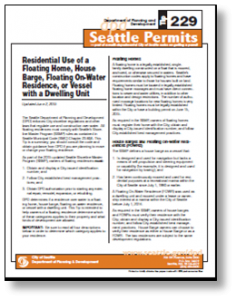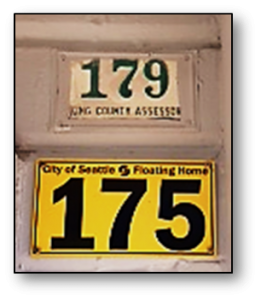Tip 229A Shoreline Permitting Requirements for Floating on Water Residences (FOWR) and House Barges
Updated 10.17.2019 – Read all about the recent changes here – http://www.seattle.gov/DPD/Publications/CAM/Tip229A.pdf
Tip 209A Shoreline Substantial Development Exemptions Application Instructions
Read all about the recent changes here – http://www.seattle.gov/DPD/Publications/CAM/cam209A.pdf
Seattle’s Shoreline Master Plan (S.M.P.)
As in the early days of the Seattle FHA, the new plan was significantly influenced by the efforts of the board using the funds that come from your annual membership dues to pay for lawyers and lobbyist in this effort. SMP regulations and details including links to the decision documents are available at the Department of Ecology website here, and you can see the Shoreline Master Program from the Seattle Department of Construction and Inspections here. If you have questions about Seattle’s Shoreline Master Program please contact Maggie Glowacki, (206) 386-4036, margaret.glowacki@seattle.gov. For Code questions, scroll down to the bottom of this page for contact information.
Seattle Shoreline Master Program Chapter 23.60A.202 pertains to Standards for Floating Homes and Moorages. Some of the key regulations that affect Floating Homes are:

- One code for all homes: This will replace the old conforming and non-conforming system.
- No additional floating homes will be permitted.
- Allowed floating homes are legally established or have a building permit on the effective date of the ordinance; or replace an existing, legally established floating home, or occupy a floating home moorage that is legally established.
- Safe Harbor: New moorages are allowed to accommodate existing homes, up to five floating homes can be moved to an existed moorage or marina (up from two), there are no parking or minimum floating home site area requirements, modifications to the setback and float separation requirements are allowed throughout the safe harbor moorage, may move floating homes around on a street end in order to fit in a house needing safe harbor.
- How High Can I Build?: No portion of any addition to a floating home exceeds: 18 feet in height, as measured from the main deck or 3 feet above the surface of the water, whichever is lower. If current height is above 18 feet, new height may not exceed current height or 21 feet, whichever is lower.
- Styrofoam: Unenclosed Styrofoam or similar material that has the potential to break apart is prohibited for use in new floats or for repairing or replacing all or parts of existing floats or for other purposes that would allow the broken pieces to enter the water.
- Environmental BMPs: The Director by Director’s Rule may establish alternative best management practices to implement the requirements of Section 23.60A.155 or may add or clarify best management practices to minimize impacts on the aquatic environment based on the science and technical information described in WAC 173-26-201(2)(a) and consistent with RCW 90.58.270(5) and 90.58.270(6). The Director shall consult with the Floating Homes Association, Lake Union Liveaboard Association, and affected stakeholders concerning interpretation and enforcement of best management practices when adopting a rule.
- Registration: A one-time fee of $95, display registration number with numbers of your choice at least 3 inches high or use the plaque issued by the city
Seattle Municipal Code Chapter 7.20.40 – Floating Home Moorages – The purpose of the ordinance codified in Chapter 7.20 is to prevent harm to the public by protecting the stability, viability, and fiscal integrity of Seattle’s unique floating home communities by preventing the eviction of floating homes from their moorages through arbitrary actions and unreasonable rent increases, and by discouraging the eviction and destruction of valuable and habitable floating homes by enhancing opportunities for floating home owners to purchase their moorages, while preserving to moorage owners the fundamental attributes of ownership.
One Time Floating Residence Fee and Plaque Questions:
- How often will I pay the City Floating Home registration fee? Answer: One time and it stays with the home even after you sell it. There is no additional fee for future owners.
- When is the one time registration fee ($95) due? Answer: It is due by December, 15 2015. (The document you received in the mail can be confusing on the due date.)
- Where do we get the plaque with our registration number?
 Answer: The city will mail you a plaque with your specific number after you pay the fee. You can also pay the fee and pick up your plaque at the DPD office (700 Fifth Ave, 7th floor). You also have the option of using numbers you buy yourself similar to your address or house number as long as they are at least 3” high and readable from a publicly accessible area.
Answer: The city will mail you a plaque with your specific number after you pay the fee. You can also pay the fee and pick up your plaque at the DPD office (700 Fifth Ave, 7th floor). You also have the option of using numbers you buy yourself similar to your address or house number as long as they are at least 3” high and readable from a publicly accessible area.
- My neighbor got their form but I did not get mine. What do I do? Answer: The office is sending them out in batches and the next batch will go out sometime in August. If you haven’t received one by September, you may want to stop by the Department of Planning and Development at 700 Fifth Ave, 7th Floor and ask for one. You can pay for it there and they will give you your little plastic plaque at the same time.
- I already have a little license plate number on my floating home, why do I need another one? Answer: The number you currently have on the old license plate is from the King County Assessor’s office and enables them to charge you the Floating Home tax each year. The new plaque is for the new city registration system, will have a different number and will not be related to a tax.
- What do I get for the $95 fee as a tax payer? Answer: The $95 fee helps defray the cost of the city registration system and pay for the plastic plaque. The new system was created by DPD, passed by the Seattle City Council and approved by the state Department of Ecology.
- Why does the city need a different number than the county number? Answer: The city and the county do not share systems. The county system is for tax purposes and the city system is to verify that each existing floating home is properly permitted under city building code. This will identify each floating home as being a city approved residence from this point forward and will ensure permanence for our community.
If you’d like more clarification or have another question you may want to contact Christine Bruno, Shoreline Code Compliance Analyst, City of Seattle Department of Construction and Inspections, P.O. Box 34019, Seattle, WA 98124-4019 P: 206.684.5040 | F: 206.615.1812| christine.bruno@seattle.gov or you can visit the website here You may also find this DPD document helpful.
